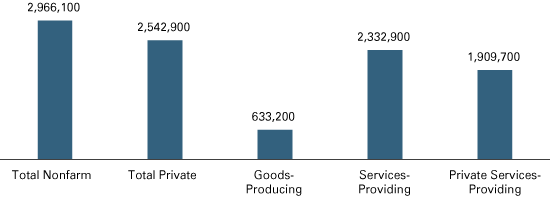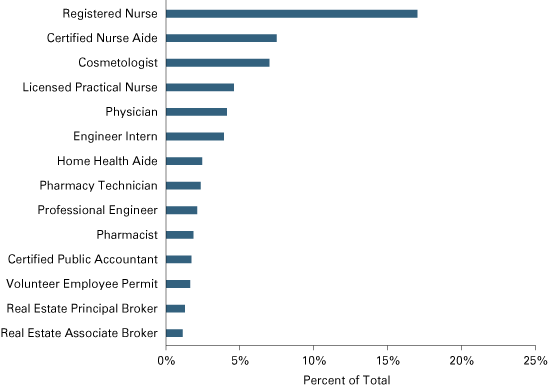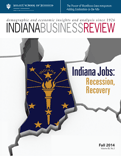The Power of Workforce Data Integration: Adding Credentials to the Mix
Deputy Director, Indiana Business Research Center, Indiana University Kelley School of Business
Measuring the workforce outcomes of secondary and postsecondary education has been a leading focus in the establishment of state longitudinal data systems for many years. This work and the catalytic funding provided by the federal government to help build, strengthen and extend these systems has created a critical infrastructure that can help lead to better education and training decisions by students, parents, teachers, workers, policymakers and the funders of these programs and institutions.
But certain gaps exist in the types of workers and their education as measured by many of these systems—chief among them, credentials. Credentials can be obtained with specialized training available through colleges, proprietary training providers, apprenticeships and sometimes through self-learning. Such credentials, either licenses or certifications or permits, can span professional and occupational services from barbering to cremation specialists. Other credentials, such as licenses to practice medicine, law or teaching, are required in addition to college degrees in order to practice in a particular state.
There is a broad array of credentials required and regulated by states. Information is sometimes available through federal agencies and associations detailing which occupations are regulated and by which specific state agencies. Many states have or are moving toward a single, one-stop agency, but many still require individuals seeking an occupational license or certification to apply to a specific board or commission for that profession, of which there are often dozens.
According to the Council of State Governments, many states are considering compacts that can legally recognize another state’s licenses, particularly relating to health care professions, as a way to create greater efficiencies for both the agency and the applicants. Such compacts have the potential to ease transferability of such licenses and allow for greater mobility among health care professionals.
The Indiana Experience
Nearly one in seven people working in Indiana have a professional or occupational license, according to the Indiana Professional Licensing Agency (PLA). That agency serves as an umbrella organization for more than 35 boards, commissions, committees and licensing bodies, such as the Medical Licensing Board and the Indiana Real Estate Commission. It regulates more than 70 professional licenses including physicians, pharmacists, nurses, accountants, dentists, veterinarians and cosmetologists.
The PLA was created in 2005 by the Indiana legislature to reduce duplication, increase efficiency and better integrate licensing requirements. This centralized administration of the multiple boards and commissions makes it easier for people to apply for licenses through a single agency. It can also make it easier for consumers, clients and patients to check on the status of professionals from whom they are receiving services.
Most important, at least to those of us seeking to integrate education and workforce outcomes, is the combined database the agency has built that includes information on the majority of professionals issued a state license, certificate or permit. That database contains more than 1.5 million records, some of which go as far back as 1905 (the majority of licenses prior to 1925 were for registered nurses). Our focus, however, is that of the more current (1990s forward) licenses of individuals for the professions covered. It is not 100 percent comprehensive, as teacher licensing collected by the Indiana Department of Education is not currently included.
Indiana Department of Workforce Development research staff worked with the PLA to obtain the necessary permissions to access the database and have developed a process for obtaining updates on a continuous basis.
The majority of people today work in the services-providing sector (see Figure 1). Knowing the number of a particular type of professional, particularly for health professionals such as doctors, nurses, chiropractors and psychiatrists, can be used to determine access rates and shortages.
Figure 1: Indiana Employment by Sector, March 2014

Source: Current Employment Statistics, U.S. Bureau of Labor Statistics
Many states, including Indiana, provide statistical summaries of the number of active licensed or certified professionals by type at the state and county levels. Figure 2 shows the most common licenses in Indiana as of 2013. These 14 licenses account for 59 percent of licenses issued in the state.
Figure 2: Top Licenses in Indiana, 2013

Source: Indiana Public Licensing Agency
But a long-known issue with these counts is the address the professional puts on the application—it can be either a work or home address and isn’t identified as one or the other. Plus, the data in their original form don’t tell us whether the professional is actually working (since having an active license doesn’t necessarily equate to actual practice).
Integration
The integration of the license information to workforce records adds important dimensions to the license and certification data. It allows us to match to place-of-work, thus obviating the problem of “home or work” address. It allows for better calculations of the potential shortages or surpluses of specific occupations and the impact of unemployment for these types of occupations. Analyzing access to these types of occupations can be enhanced based on labor shed and commuting shed analysis. And of course, results from this integration can provide critical information for training and education programs in our state and regions. Matching to employment also tells us how many professionals keep their licenses active, but aren’t actually working in the state—something the license database by itself cannot do.
Integration also adds the dimensions of continuing education, as measured through the integration with public college and training programs and the range of wages earned. Ultimately, we want to get a more complete picture of the employment prospects for those seeking to enter the types of occupations covered by the licensure data. Career pathways information for students and workers is enhanced by having more robust near-real-time and location-based information on outcomes for people seeking careers that require licensing or certification, as well.
Examples
Accountants (aka certified public accountants) are one of the many professional groups certified by the State of Indiana. Nearly 10,000 accountants were certified in 2013. A large proportion of those (35.1 percent) wind up working in the professional services industry (most likely for an accounting or legal firm). There is a significant spread of accountants across industries, though, including work in the executive and legislative branches of government; real estate; health care; manufacturing; and other industries where they are either occupied as accountants or have taken on other work.
Licensed practical nurses, on the other hand, are employed primarily in the health care industry (no surprise at 79 percent), but nearly 1,000 can be found in the administrative industry and educational services. Physicians are also predominantly in the health care industry, but there is a small but accelerating percentage of them in the management of companies and enterprises category (2.6 percent in 2009 rose to 6 percent in 2013).
More Work Ahead
Thanks to a grant from the Employment and Training Administration for the Workforce Data Quality Initiative (WDQI), Indiana’s Department of Workforce Development and the IBRC will be able to expand and enhance the integration of licensing with workforce data and begin to provide more information to a public that is anxious to see outcomes for these types of credentials. As the grant name indicates, the quality of the workforce data available will be improved.
For more information on Indiana’s integration of licensing data, feel free to contact the author at rogersc@indiana.edu or the program director for the WDQI grant, Allison Leeuw (aleeuw@dwd.in.gov). For more information on the State of Indiana’s statewide longitudinal data system, see the Indiana Network of Knowledge website at www.in.gov/ink.
References and Resources
- The Indiana Professional Licensing Agency maintains a database on all professionals that have been issued a license, certificate, registration or permit. All of the information in the database is public information and it does not contain any confidential information, such as Social Security numbers or examination results. Through the www.in.gov/pla website, you can search the entire database or select parameters for specific information.
- A nationwide study of professional and occupational licensing, registration and permits, using results of a Gallup survey, is available in a whitepaper. See Alan Krueger and Morris Kleiner, “The Prevalence and Effects of Occupational Licensing,” CEPS Working Paper No. 174, August 2008, https://citeseerx.ist.psu.edu/viewdoc/download?doi=10.1.1.445.9415&rep=rep1&type=pdf.
- A first of its kind report from the U.S. Census Bureau measures alternative credentials—i.e., not a college degree but a license or certificate—based on the Survey of Income and Program Participation. See Stephanie Ewert and Robert Kominski, “Measuring Alternative Educational Credentials: 2012,” January 2014,www.census.gov/library/publications/2014/demo/p70-138.html.
- The Council on Licensure, Enforcement and Regulation provides education for state licensing officials and has numerous blog posts and articles on nationwide issues relating to state licensure. One article reviews trends in such licensing: See Pam Brinegar, “Professional and Occupational Regulation,” The Book of the States 2006,https://licensing.csg.org/professional-licensing/
- Medical licensing compacts are gaining traction and the Council of State Governments is devoting considerable energy to providing information on this initiative. See Crady deGolian, “Medical Licensing Compacts Backgrounder, The Council of State Governments Knowledge Center, October 2013, https://www.imlcc.org/.
- Indiana Regulated Occupations Evaluation Report, July 1, 2011, http://iga.in.gov/legislative/2014/publications/agency/reports/license/.
- Note: The Job Creation Committee was established by the 2014 Indiana General Assembly to assess the efficiency and effectiveness of all professional licenses regulated by the PLA.




